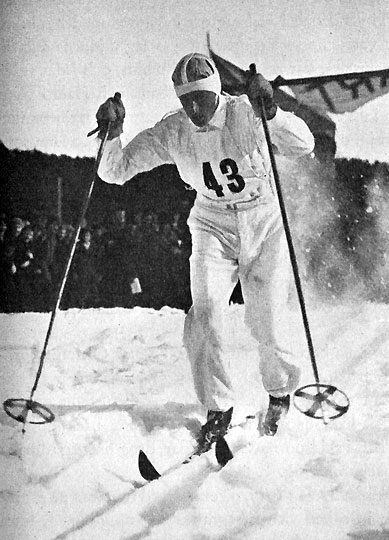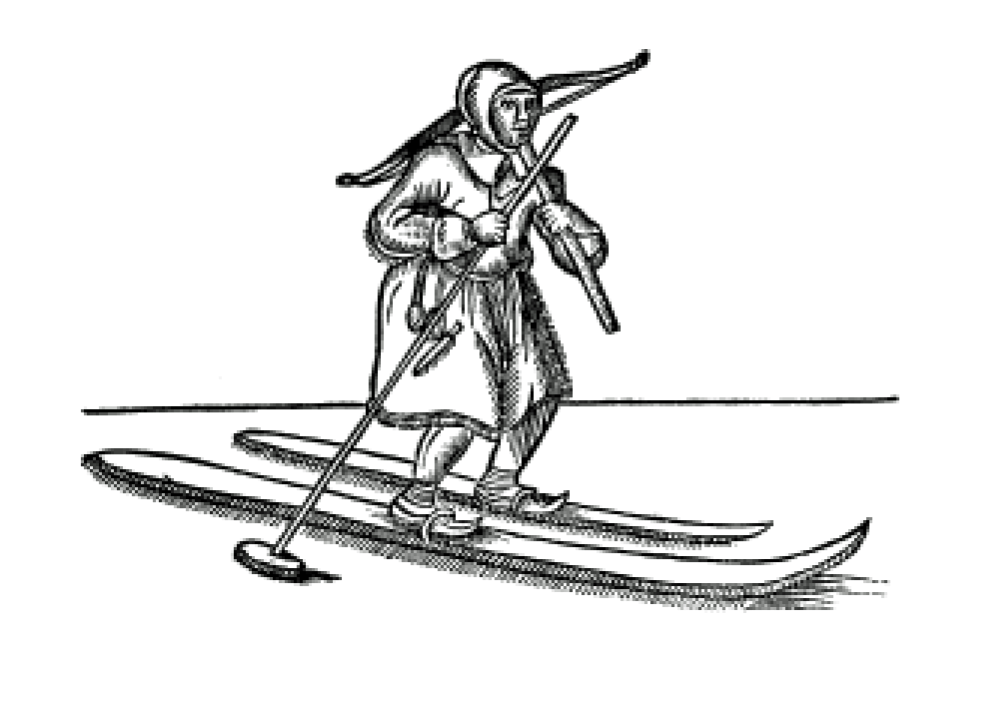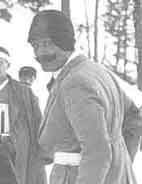|
Ski Touring
Ski touring is skiing in the backcountry on unmarked or unpatrolled areas. Touring is typically done off-piste and outside of ski resorts, and may extend over a period of more than one day. It is similar to backcountry skiing but excludes the use of a ski lift or transport. Ski touring combines elements of Nordic skiing, Nordic and alpine skiing and embraces such sub-disciplines as Telemark skiing, Telemark and ''randonnée''. A defining characteristic is that the skier's heels are "free" – i.e. not bound to the skis – in order to allow a natural gliding motion while traversing and ascending terrain which may range from perfectly flat to extremely steep. Ski touring has been adopted by skiers seeking new snow, by alpinists, and by those wishing to avoid the high costs of traditional alpine skiing at resorts. Touring requires independent navigation skills and may involve route-finding through potential avalanche terrain. It has parallels with hiking and Backpacking (wildern ... [...More Info...] [...Related Items...] OR: [Wikipedia] [Google] [Baidu] |
Snowshoe Thompson
John Albert Thompson (born Jon Torsteinsson Rue; April 30, 1827 – May 15, 1876), nicknamed Snowshoe Thompson, an early resident of the Sierra Nevada of Nevada and California, was a Norwegian-American considered to be the father of California skiing. Background Jon Torsteinsson Rue was born on the Rue farm in Austbygdi, Telemark, Austbygdi, Tinn in Telemark, Norway. He was the son of Torsten Olsen Rue (ca. 1760–1829) and Gro Jonsdatter Håkaland (1781-ca. 1846). His father died when Thompson was 2 years old. In 1837, at the age of 10, Thompson came to America with his mother, settling first on a farm in Norway, Illinois, Norway, LaSalle County, Illinois at the Fox River Settlement. The family subsequently moved on the Norwegian immigrant settlement in Shelby County, Missouri which was under the leadership of Cleng Peerson. In 1839, they were joined by Thompson's brother Tostein (1819-1880) and sister Kari (born 1822). In 1840, they followed Hans Barlien and moved to the Sugar ... [...More Info...] [...Related Items...] OR: [Wikipedia] [Google] [Baidu] |
Ski Wax
Ski wax is a material applied to the bottom of snow runners, including skis, snowboards, and toboggans, to improve their coefficient of friction performance under varying snow conditions. The two main types of wax used on skis are glide waxes and grip waxes. They address kinetic friction—to be minimized with a glide wax—and static friction—to be achieved with a grip wax. Both types of wax are designed to be matched with the varying properties of snow, including crystal type and size, and moisture content of the snow surface, which vary with temperature and the temperature history of the snow. Glide wax is selected to minimize sliding friction for both alpine and cross-country skiing. Grip wax (also called "kick wax") provides on-snow traction for cross-country skiers, as they stride forward using classic technique. Modern plastic materials (e.g. high-modulus polyethylene and Teflon), used on ski bases, have excellent gliding properties on snow, which in many circumstances ... [...More Info...] [...Related Items...] OR: [Wikipedia] [Google] [Baidu] |
Alpine Touring Binding
A ski binding is a device that connects a ski boot to the ski. Before the 1933 invention of ski lifts, skiers went uphill and down and cross-country on the same gear. As ski lifts became more prevalent, skis—and their bindings—became increasingly specialized, differentiated between alpine (downhill) and Nordic ( cross-country, Telemark, and ski jumping) styles of skiing. Until the point of divergence in the mid-20th century, bindings held the toe of a flexible, leather boot against the ski and allowed the heel to rise off the ski, typically with a form of strap or cable around the heel. To address injuries resulting from falls while skiing downhill on such equipment, ski bindings emerged with the ability to release the toe of the boot sideways, in early models, and to release the boot forward and aft, in later models. Downhill ski bindings became standardized to fit plastic ski boots and incorporated a built-in brake that drags in the snow after the ski detaches from the bo ... [...More Info...] [...Related Items...] OR: [Wikipedia] [Google] [Baidu] |
Cross-country Skiing
Cross-country skiing is a form of skiing whereby skiers traverse snow-covered terrain without use of ski lifts or other assistance. Cross-country skiing is widely practiced as a sport and recreational activity; however, some still use it as a means of travel. Variants of cross-country skiing are adapted to a range of terrain which spans unimproved, sometimes mountainous terrain to groomed courses that are specifically designed for the sport. Modern cross-country skiing is similar to the original form of skiing, from which all skiing disciplines evolved, including alpine skiing, ski jumping and Telemark skiing. Skiers propel themselves either by striding forward (classic style) or side-to-side in a skating motion (skate skiing), aided by arms pushing on ski poles against the snow. It is practised in regions with snow-covered landscapes, including Europe, Canada, Russia, the United States, Australia and New Zealand. Cross-country skiing (sport), Competitive cross-country skiing i ... [...More Info...] [...Related Items...] OR: [Wikipedia] [Google] [Baidu] |
Alpine Skiing
Alpine skiing, or downhill skiing, is the pastime of sliding down snow-covered slopes on skis with fixed-heel Ski binding, bindings, unlike other types of skiing (Cross-country skiing, cross-country, Telemark skiing, Telemark, or ski jumping), which use skis with free-heel bindings. Whether for recreation or for sport, it is typically practiced at ski resorts, which provide such services as ski lifts, artificial snow making, snow grooming, restaurants, and ski patrol. "Piste, Off-piste" skiers—those skiing outside ski area boundaries—may employ snowmobiles, heliskiing, helicopters or Snowcat, snowcats to deliver them to the top of a slope. Back country skiing, Back-country skiers may use specialized equipment with a free-heel mode, including 'sticky' Ski skins, skins on the bottoms of the skis to stop them sliding backwards during an ascent, then locking the heel and removing the skins for their descent. Alpine ski racing has been held at the Alpine skiing at the Win ... [...More Info...] [...Related Items...] OR: [Wikipedia] [Google] [Baidu] |
Ski Skins
Climbing skins are strips that attach to the bottom of Nordic skiing, Nordic, ski touring, alpine touring or randonnée skis to help while ascending backcountry slopes. They are designed to be removed for skiing downhill. They are typically attached to the skis via a loop on the ski tip, a hook on the tail, and adhesive on the base of the skin. They are called skins because they resemble sealskin, from which the first ski skins were made. They are typically made from nylon or mohair or a combination thereof, and are designed to let the ski slide forward on snow but not backward. They are usually narrower than the ski to allow the ski edges to get a grip. Some ski resorts permit skinning. History Various ethnic groups living in the Arctic regions created a means of transportation across the ice and snow surfaces of their regions, with innovations such as the ski. Attuned to maximizing the use of their materials, one outcome of their innovation was the use of animal skins to gain ... [...More Info...] [...Related Items...] OR: [Wikipedia] [Google] [Baidu] |
Kilian Jornet Burgada
Killian or Kilian, as a given name, is an Anglicized version of the Irish name . The name was borne by several early Irish saints including missionaries to Artois (France) and Franconia (Germany) and the author of the life of St Brigid. The name is said to derive from Saint Kilian, an Irish missionary to Germany in the 7th century, who, according to the Acta Sanctorum, was born in Mullagh, County Cavan, Ireland c. 640. He departed for his mission to the continent with 12 apostles from Kilmacologue in the parish of Tuosist, County Kerry, Ireland. In 689, he was martyred in Würzburg, now in Bavaria, and subsequently became the city's patron saint. The most likely meaning of the name is 'little church', a reference to someone prayerful or spiritual, meaning 'church' in the Irish language, while the suffix is used affectionately to indicate a "pet" or diminutive status. Patrick Woulfe wrote that is a diminutive of which means 'war', 'strife', or 'bright-headed'. Notable peop ... [...More Info...] [...Related Items...] OR: [Wikipedia] [Google] [Baidu] |
Patrick Vallençant
Patrick Vallençant (9 June 1946 – 28 March 1989) was a French alpine skiing, alpinist/skier and pioneer in ski mountaineering. He was a pioneer in ski mountaineering and leader of the French school of ski mountaineers. His motto was: "si tu tombes, tu meurs", translated as "you fall, you die". In addition to numerous first descents, he was responsible for the creation of the "Pedal-Jump Turn" and co-founded the Degré 7 ski apparel company. He died on 28 March 1989, in a non-skiing related climbing accident as a result of a broken carabiner, while abseiling from the top of La Beaume Rouge, in France. Skiing Vallençant became known for a number of first descents on skis within the French Alps that had previously been considered too steep to ski. To achieve this he developed a ski technique known as the "Pedal-Jump Turn". His feats required him to first climb the mountain in order to make the descent on skis, at the time it was uncommon to use helicopters to reach the top. ... [...More Info...] [...Related Items...] OR: [Wikipedia] [Google] [Baidu] |
Ottorino Mezzalama
Ottorino Mezzalama (born 25 September 1888 – 23 February 1931) was an Italian mountain climber, and is deemed to be one of the two pioneers of Italian ski mountaineering besides Luciano Roiti. He died in an avalanche accident in the Rochemolles Valley. The ''Ottorino Mezzalama'' Hut of the Club Alpino Italiano (CAI) below Pollux as well as the famous Mezzalama Trophy competition and the Mezzalama Skyrace were named in honor of him. Life Mezzalama was born in Bologna and moved with his family to Turin on 28 March 1892. In his teens he gained first experiences in mountain climbing. He was a good friend of the Swiss engineer Adolfo Kind and of the artillery Lieutenant Luciano Roiti, who published "Delle marce sulla neve" (Italian for ''about marching on snow''), a paper about ski mountaineering in the army. All three became members of the CAI and founded the Ski Club Torino. After he finished school, Mezzalama began his studies at the university faculty of trading and economy, ... [...More Info...] [...Related Items...] OR: [Wikipedia] [Google] [Baidu] |
Arnold Lunn
Sir Arnold Henry Moore Lunn (18 April 1888 – 2 June 1974) was a skier, mountaineer and writer. He was knighted for "services to British Skiing and Anglo-Swiss relations" in 1952. His father was a lay Methodist minister, but Lunn was an agnostic and wrote critically about Catholicism before he converted to that religion at the age of 45 and became an apologist. He was born in Madras, India''Who's Who 1945''. London: Adam & Charles Black, p. 1688, where there is a very large entry for Lunn. and died in London aged 86. Early life Arnold Lunn was born in Madras, eldest of three sons and a daughter of Sir Henry Simpson Lunn (1859–1939) and Mary Ethel, née Moore, daughter of a canon. His father was firstly a Methodist minister and later founder of Lunn's Travel agency (that would become Lunn Poly), which encouraged tourism in the Swiss Alps. Arnold Lunn's two brothers were also authors. Hugh Kingsmill Lunn became a noted literary journalist under the name Hugh Kingsmill ... [...More Info...] [...Related Items...] OR: [Wikipedia] [Google] [Baidu] |






